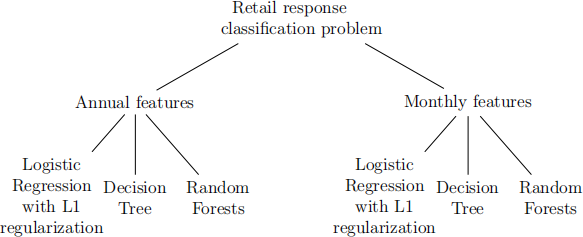CHE1148H - Data Mining in Engineering Programming assignment #3
Hello, dear friend, you can consult us at any time if you have any questions, add WeChat: daixieit
Programming assignment #3
Course: CHE1148H - Data Mining in Engineering
1 Supervised learning
With the features built in Assignment #2, you are now asked to build a model that pre- dicts clients response to a promotion campaign using 3 MLlib algorithms. This is a typical classification problem in the retail industry, but the formulation of the problem is similar to industries such as fraud detection, marketing and manufacturing.
The clients responses are stored in the Retail Data Response.csv file from Kaggle. The responses are binary: 0 for clients who responded negatively to the promotional campaign and 1 for clients who responded positively to the campaign.
You will explore solving the classification problem with two different sets of features (i.e. annual and monthly) and three different algorithms as shown in the image below.

1.1 Import the monthly and annual data and join
In Assignment #2, you created five different feature families that capture annual and monthly aggregations. Here, you will model the retail problem with two approaches: using annual and monthly features. Therefore, you need to create the joined tables based on the following logic:

In both the annual and monthly features approach, you need to join at the end with table #4, the clients responses. This is simply a table that contains the binary response of the client to our marketing effort as described above and that is the output or label or target that makes this a supervised learning problem.
1.2 Steps for each method (15 points)
Important note 1: When you set up a new cluster in Databricks make sure that you select a runtime version that supports ML (any 10.x ML should work).
Important note 2: The Learning Spark book githubhas many useful notebooks in Chapter 10 relevant to ML pipelines.
1. Separate the inputs X and the output y in two data frames.
2. Split the data in train and test set. Use a test size value of 2/3 and set the random state equal to 1147 for consistency (i.e. the course code value). Use the following names for consistency.

3. Pre-process (if necessary for the method).
4. Fit the training dataset and optimize the hyperparameters of the method.
5. Plot coefficient values or feature importance.
6. Plot probability distribution for test set.
7. Plot confusion matrix and ROC curves of train/test set. Calculate precision/recall.
1.3 Comparison of methods (5 points)
Compare the two feature engineering (annual and monthly) and the three modeling ap- proaches (L1 log-reg, tree, forests) in terms of the outcomes of steps 5-7. Which combina- tion of feature engineering and modeling approach do you select as the best to deploy in a production environment and why? Tabularize your findings in steps 5-7 to summarize the results and support your decision (how to organize information with tables in Markdown).
2023-03-14